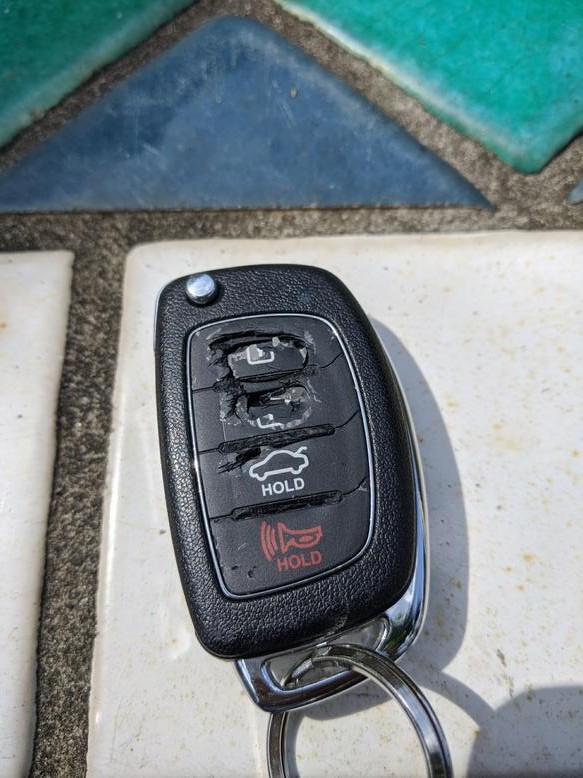Experiencing a crumbling key fob on your 2015 Hyundai Sonata? You’re not alone. Many owners find the plastic casing around the buttons disintegrates over time, leaving them with a functional but unsightly and fragile key fob. My own 2015 Sonata Sport faced this exact problem – the buttons on my key fob simply fell apart after years of use. Thinking it was just wear and tear, I grabbed my spare, a brand new, never-used fob. To my surprise, within a day, the spare suffered the same fate, crumbling in the same way. This clearly pointed to a material defect rather than simple wear.
Like many car owners in this situation, my first thought was a simple key fob shell replacement. Online videos suggested it was an easy DIY task: just buy a replacement shell, transfer the internal electronics, and you’re good to go. Eager to save money and fix it myself, I ordered a generic key fob shell online for around $20. Upon arrival, the new shell looked promising, and the transfer process seemed straightforward, at least in theory. The first hurdle appeared when trying to open the original, broken fob. It was clear there was no easy way in – the casing was glued or fused shut. Forcibly opening it was the only option, essentially destroying the original shell in the process.
With the original fob now open, I attempted to transfer the internal components – the chip and switchblade key – into the new generic shell. This is where the real issues started. While the parts seemed to mostly fit, they weren’t quite right. The new fob’s housing for the chip was slightly deeper and wider, causing the chip to sit loosely. The original key blade also proved to be a bit too thick for the new casing, preventing it from closing completely. It seemed modification would be necessary, a point echoed in some of the online videos I’d watched, mentioning that these generic shells often require some level of adjustment.
Undeterred initially, I even tried using a Dremel tool to file down the key blade to fit the generic shell. However, I soon realized that the problem wasn’t just the thickness of the blade. The insertion pin was also slightly offset. At this point, I had to concede defeat – the generic shell wasn’t going to work without significant and potentially damaging modifications.
The obvious next thought was to abandon the cheap generic option and go for an OEM (Original Equipment Manufacturer) shell. Surely, a genuine part would fit perfectly, right? I ordered an OEM casing for around $40. However, upon receiving it, I discovered another problem: OEM shells aren’t designed to be easily opened for component transfer like the generic aftermarket ones. Like the original fob, the OEM shell also seemed to be sealed shut, meaning opening it would likely involve destruction. The alternative? Taking the OEM casing to a locksmith for programming and key cutting, which would cost an additional $175, or going to the dealership for a complete replacement, quoted at a minimum of $350.
This experience raises the question: Is there a truly easy and affordable way to replace the shell of a 2015 Hyundai Sonata key fob? The journey from a simple DIY fix to potentially expensive locksmith or dealer services highlights the challenges. Are we missing a simpler solution, or is the reality that replacing a 2015 Hyundai Sonata key fob shell is more complicated and costly than it initially appears? Perhaps the quest for the perfect, budget-friendly 2015 Hyundai Sonata Key Fob Shell Replacement continues.

